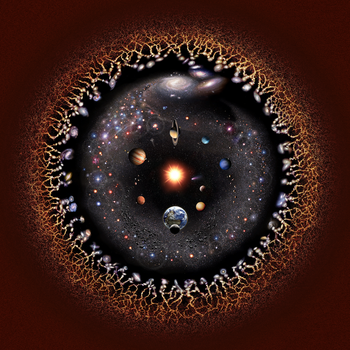
Back موقع الأرض في الكون Arabic Lokacija Zemlje BS Ubicació de la Terra en l'Univers Catalan Pozice Země ve vesmíru Czech Position der Erde im Universum German Τοποθεσία της Γης στο Σύμπαν Greek Ubicación de la Tierra en el universo Spanish Lurraren kokalekua unibertsoan EU موقعیت زمین در جهان FA Situation de la Terre dans l'Univers French
Logarithmic representation of the universe centered on the Solar System. Celestial bodies on this graphic are clickable |
Knowledge of the location of Earth has been shaped by 400 years of telescopic observations, and has expanded radically since the start of the 20th century. Initially, Earth was believed to be the center of the Universe, which consisted only of those planets visible with the naked eye and an outlying sphere of fixed stars.[1] After the acceptance of the heliocentric model in the 17th century, observations by William Herschel and others showed that the Sun lay within a vast, disc-shaped galaxy of stars.[2] By the 20th century, observations of spiral nebulae revealed that the Milky Way galaxy was one of billions in an expanding universe,[3][4] grouped into clusters and superclusters. By the end of the 20th century, the overall structure of the visible universe was becoming clearer, with superclusters forming into a vast web of filaments and voids.[5] Superclusters, filaments and voids are the largest coherent structures in the Universe that we can observe.[6] At still larger scales (over 1000 megaparsecs[a]) the Universe becomes homogeneous, meaning that all its parts have on average the same density, composition and structure.[7]
Since there is believed to be no "center" or "edge" of the Universe, there is no particular reference point with which to plot the overall location of the Earth in the universe.[8] Because the observable universe is defined as that region of the Universe visible to terrestrial observers, Earth is, because of the constancy of the speed of light, the center of Earth's observable universe. Reference can be made to the Earth's position with respect to specific structures, which exist at various scales. It is still undetermined whether the Universe is infinite. There have been numerous hypotheses that the known universe may be only one such example within a higher multiverse; however, no direct evidence of any sort of multiverse has been observed, and some have argued that the hypothesis is not falsifiable.[9][10]
- ^ Kuhn, Thomas S. (1957). The Copernican Revolution. Harvard University Press. pp. 5–20. ISBN 978-0-674-17103-9.
- ^ "1781: William Herschel Reveals the Shape of our Galaxy". Carnegie Institution for Science. Archived from the original on 26 March 2014. Retrieved 19 March 2014.
- ^ "The Spiral Nebulae and the Great Debate". Eberly College of Science. Retrieved 22 April 2015.
- ^ "1929: Edwin Hubble Discovers the Universe is Expanding". Carnegie Institution for Science. Archived from the original on 7 January 2019. Retrieved 22 April 2015.
- ^ "1989: Margaret Geller and John Huchra Map the Universe". Carnegie Institution for Science. Archived from the original on 7 January 2019. Retrieved 22 April 2015.
- ^ Villanueva, John Carl (2009). "Structure of the Universe". Universe Today. Retrieved 22 April 2015.
- ^ Kirshner, Robert P. (2002). The Extravagant Universe: Exploding Stars, Dark Energy and the Accelerating Cosmos. Princeton University Press. p. 71. ISBN 978-0-691-05862-7.
- ^ Mainzer, Klaus; Eisinger, J. (2002). The Little Book of Time. Springer. p. 55. ISBN 978-0-387-95288-8.
- ^ Moskowitz, Clara (2012). "5 Reasons We May Live in a Multiverse". space.com. Retrieved 29 April 2015.
- ^ Kragh, H. (2009). "Contemporary History of Cosmology and the Controversy over the Multiverse". Annals of Science. 66 (4): 529–551. doi:10.1080/00033790903047725. S2CID 144773289.
Cite error: There are <ref group=lower-alpha> tags or {{efn}} templates on this page, but the references will not show without a {{reflist|group=lower-alpha}} template or {{notelist}} template (see the help page).



